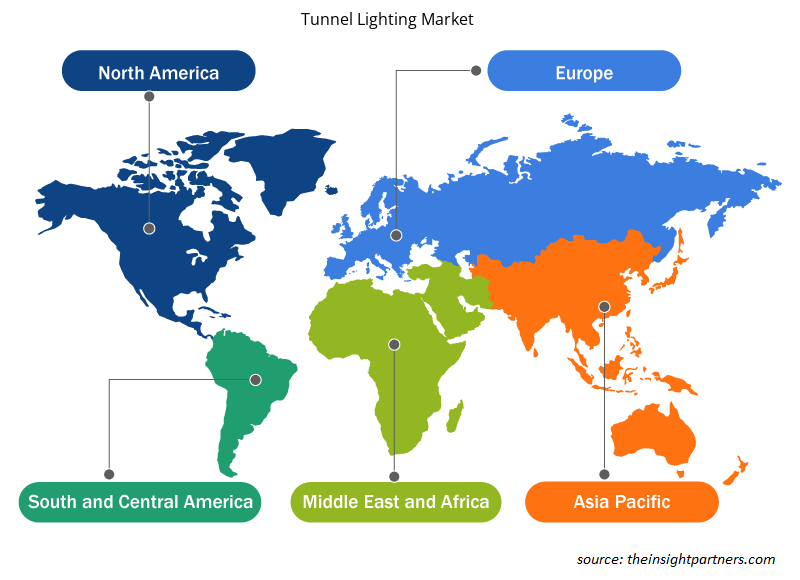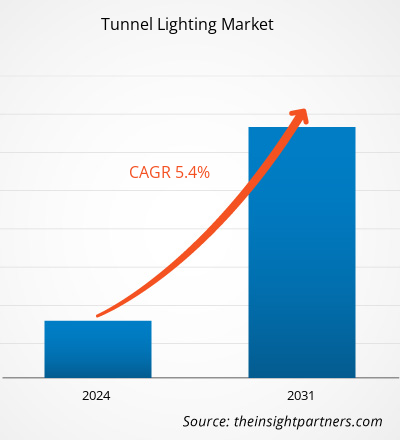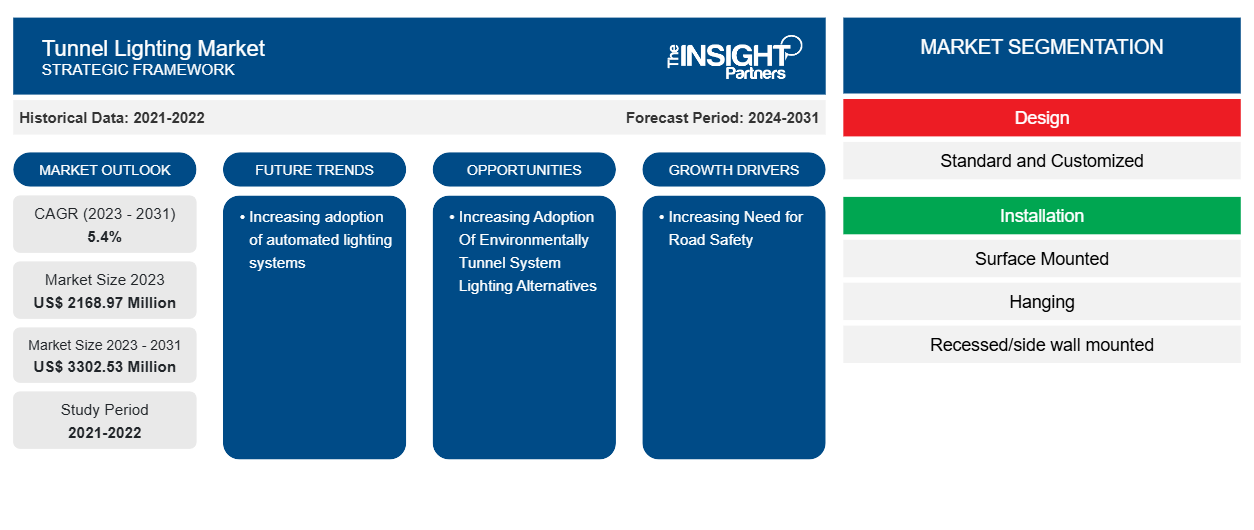La taille du marché de l'éclairage des tunnels devrait atteindre 3 302,53 millions USD d'ici 2031, contre 2 168,97 millions USD en 2023. Le marché devrait enregistrer un TCAC de 5,4 % au cours de la période 2023-2031. L'adoption croissante de systèmes d'éclairage automatisés devrait rester une tendance clé du marché.CAGR of 5.4% during 2023–2031. Increasing adoption of automated lighting systems is likely to remain a key trend in the market.
Analyse du marché de l'éclairage des tunnels
Le chemin de fer joue un rôle essentiel dans le système de transport de toute économie, car le développement du commerce et de l'industrie dépend en grande partie du développement des infrastructures de transport. Les chemins de fer sont non seulement considérés comme une source de transport rentable, mais aussi fiable. De grandes quantités de marchandises et de passagers peuvent être transportées sur de longues distances avec un minimum de risques de pannes ou de retards par rapport aux routes. De plus, la capacité de charge des trains est élastique car le nombre de wagons peut être augmenté ou diminué. En outre, il s'agit de l'un des moyens de transport les plus respectueux de l'environnement, car les locomotives ferroviaires modernes sont alimentées électriquement par rapport aux moteurs diesel classiques. En raison de ces avantages, les gouvernements du monde entier se concentrent de plus en plus sur le développement de leur réseau ferroviaire. Ainsi, l'accent mis sur le développement des réseaux ferroviaires à travers le monde devrait stimuler le marché de l'éclairage des tunnels.
Aperçu du marché de l'éclairage des tunnels
Un bon éclairage de tunnel garantit que le conducteur s'adapte à la lumière à l'intérieur du tunnel à l'entrée du tunnel. Il crée un environnement de conduite sûr en fournissant un éclairage adéquat à travers le tunnel. Le conducteur doit entrer dans le tunnel sans aucun impact négatif, traverser le tunnel et en sortir. L'éclairage diurne dans les tunnels a des exigences plus spécifiques en raison de problèmes d'adaptation. Les faibles niveaux d'éclairage dans le tunnel provoqueront une cécité temporaire du conducteur à l'entrée du tunnel et à l'intérieur du tunnel, car le conducteur a été exposé à des niveaux élevés de soleil pendant une longue période. Pour cette raison, l'éclairage du tunnel doit être modifié progressivement pour permettre au conducteur de s'adapter.
Personnalisez ce rapport en fonction de vos besoins
Vous bénéficierez d'une personnalisation gratuite de n'importe quel rapport, y compris de certaines parties de ce rapport, d'une analyse au niveau des pays, d'un pack de données Excel, ainsi que de superbes offres et réductions pour les start-ups et les universités.
-
Obtenez les principales tendances clés du marché de ce rapport.Cet échantillon GRATUIT comprendra une analyse de données, allant des tendances du marché aux estimations et prévisions.
Facteurs moteurs et opportunités du marché de l'éclairage des tunnels
Besoin croissant de sécurité routière
Les tunnels routiers, en particulier les tunnels autoroutiers, font partie des zones les plus sujettes aux accidents en raison de la vitesse élevée des véhicules. Il est donc important de maintenir des conditions d'éclairage suffisantes à l'intérieur du tunnel pour assurer une circulation fluide. Un éclairage optimal permet aux conducteurs de véhicules d'identifier les obstacles et de naviguer dans le tunnel sans réduire leur vitesse. Le guide CIE pour les systèmes d'éclairage des tunnels oblige les intégrateurs de systèmes à prendre en compte 5 domaines clés : le système d'éclairage des tunnels de zone de transition, le système d'éclairage des tunnels de zone d'accès, le système d'éclairage des tunnels de zone de sortie et le système d'éclairage des tunnels de zone intérieure. En outre, le système d'éclairage des tunnels de zone de seuil et le développement des réseaux routiers dans les terrains reculés et montagneux conduisent à la construction de nouveaux tunnels routiers. Par conséquent, l'augmentation du nombre de projets de développement de tunnels routiers, associée à l'importance croissante de la sécurité routière, stimule la croissance du marché de l'éclairage des tunnels.CIE Guidance for tunnel lighting systems compels system integrators to consider 5 key areas—transition zone tunnel lighting system, access zone tunnel lighting system, exit zone tunnel lighting system, and interior zone tunnel lighting system. Furthermore, the threshold zone tunnel lighting system and the growing road networks in remote and mountainous terrains are leading to the construction of newer roadway tunnels. Hence, the rise in the number of roadway tunnel development projects, coupled with the increasing importance of road safety, is driving the growth of the tunnel lighting market.
Adoption croissante d'alternatives d'éclairage de tunnel respectueuses de l'environnement
Le problème de l’éclairage qui arrive dans les décharges est aggravé par le fait que divers équipements d’éclairage usagés qui arrivent dans les décharges sont dangereux. L’éclairage fluorescent, qui comprend normalement des ampoules à économie d’énergie et des tubes d’éclairage, contient souvent du mercure et est donc classé comme déchet dangereux en vertu de la directive DEEE adoptée par le Royaume-Uni et l’Union européenne (UE). Les équipements d’éclairage constituent un danger pour la santé humaine et l’environnement, avec le risque que des matières dangereuses contaminent le sol, l’air et les eaux souterraines. Le reconditionnement de l’éclairage offre une alternative plus sûre et plus sécurisée. Le processus consiste à réparer ou à remplacer des composants, à démonter les luminaires usagés, puis à les remonter dans un état satisfaisant qui est aussi bon que l’original. La réduction des déchets électroniques et l’allongement du cycle de vie des produits contribuent à favoriser des pratiques plus circulaires dans l’industrie. Ainsi, l’adoption croissante d’alternatives environnementales pour l’éclairage des tunnels crée davantage d’opportunités pour le marché.WEEE Directive adopted by both the UK and the European Union (EU). Lighting equipment is a danger to human health and the environment, with the risk of hazardous materials contaminating the soil, air, and groundwater. Lighting remanufacture provides a safer and more secure alternative to this. The process involves repairing or replacing components, disassembling used lighting fixtures, and then reassembling them to a satisfactory condition that is as good as the original. Reducing electronic waste and extending the life cycle of products helps contribute to fostering more circular practices in the industry. Thus, the increasing adoption of environmental tunnel system lighting alternatives is creating more opportunities for the market.
Analyse de segmentation du rapport sur le marché de l'éclairage des tunnels
Les segments clés qui ont contribué à l’élaboration de l’analyse du marché de l’éclairage des tunnels sont la conception, l’installation, le type et l’application.
- En fonction de la conception, le marché de l'éclairage des tunnels est divisé en standard et personnalisé. Le segment personnalisé détenait une part de marché plus importante en 2023.
- En termes d'installation, le marché est segmenté en montage en surface, en suspension et en montage mural encastré/latéral. Le segment des montages en surface détenait une part de marché plus importante en 2023.
- Par type, le marché est segmenté en éclairage LED, éclairage à incandescence, éclairage fluorescent et autres.
- Par application, le marché est segmenté en tunnels miniers, tunnels routiers, tunnels ferroviaires et autres.
Analyse des parts de marché de l'éclairage des tunnels par zone géographique
La portée géographique du rapport sur le marché de l’éclairage des tunnels est principalement divisée en cinq régions : Amérique du Nord, Asie-Pacifique, Europe, Moyen-Orient et Afrique, et Amérique du Sud et centrale.
L'APAC domine le marché de l'éclairage des tunnels. Le marché de l'éclairage des tunnels dans cette région est en croissance en raison de divers facteurs, tels que l'augmentation des initiatives gouvernementales visant à améliorer la visibilité de l'éclairage des tunnels et la présence d'une industrie des transports bien établie.
Aperçu régional du marché de l'éclairage des tunnels
Les tendances régionales et les facteurs influençant le marché de l’éclairage des tunnels tout au long de la période de prévision ont été expliqués en détail par les analystes d’Insight Partners. Cette section traite également des segments et de la géographie du marché de l’éclairage des tunnels en Amérique du Nord, en Europe, en Asie-Pacifique, au Moyen-Orient et en Afrique, ainsi qu’en Amérique du Sud et en Amérique centrale.

- Obtenez les données régionales spécifiques au marché de l'éclairage des tunnels
Portée du rapport sur le marché de l'éclairage des tunnels
| Attribut de rapport | Détails |
|---|---|
| Taille du marché en 2023 | 2 168,97 millions de dollars américains |
| Taille du marché d'ici 2031 | 3 302,53 millions de dollars américains |
| Taux de croissance annuel composé mondial (2023-2031) | 5,4% |
| Données historiques | 2021-2022 |
| Période de prévision | 2024-2031 |
| Segments couverts |
Par conception
|
| Régions et pays couverts |
Amérique du Nord
|
| Leaders du marché et profils d'entreprises clés |
|
Densité des acteurs du marché de l'éclairage des tunnels : comprendre son impact sur la dynamique commerciale
Le marché de l'éclairage des tunnels connaît une croissance rapide, tirée par la demande croissante des utilisateurs finaux en raison de facteurs tels que l'évolution des préférences des consommateurs, les avancées technologiques et une plus grande sensibilisation aux avantages du produit. À mesure que la demande augmente, les entreprises élargissent leurs offres, innovent pour répondre aux besoins des consommateurs et capitalisent sur les tendances émergentes, ce qui alimente davantage la croissance du marché.
La densité des acteurs du marché fait référence à la répartition des entreprises ou des sociétés opérant sur un marché ou un secteur particulier. Elle indique le nombre de concurrents (acteurs du marché) présents sur un marché donné par rapport à sa taille ou à sa valeur marchande totale.
Les principales entreprises opérant sur le marché de l'éclairage des tunnels sont :
- MARQUES ACUITY, INC.
- Fabrication de Kenall
- Technologie d'éclairage Aeon Inc.
- Signify Holding (Philips)
- Schréder
- Éclairage Thorlux
Avis de non-responsabilité : les sociétés répertoriées ci-dessus ne sont pas classées dans un ordre particulier.

- Obtenez un aperçu des principaux acteurs du marché de l'éclairage des tunnels
Actualités et développements récents du marché de l'éclairage des tunnels
Le marché de l'éclairage des tunnels est évalué en collectant des données qualitatives et quantitatives après des recherches primaires et secondaires, qui comprennent d'importantes publications d'entreprise, des données d'association et des bases de données. Quelques-uns des développements du marché de l'éclairage des tunnels sont énumérés ci-dessous :
- Signify a annoncé l'installation d'un éclairage LED dans le tunnel Ahmed Hamdy 2 récemment inauguré. Signify utilise les derniers systèmes d'éclairage conformes aux spécifications internationales pour permettre le contrôle à distance de l'éclairage tout en réalisant jusqu'à 70 % d'économies d'énergie. (Source : Signify, communiqué de presse, octobre 2021)
- Le groupe Tungsram a signé en décembre un accord pour l’installation de l’éclairage du « Túnel de Tresponts » en Espagne. Ce projet marque le sixième contrat d’éclairage de tunnel remporté par l’entreprise basée à Budapest en Espagne en 2020, une avancée considérable au vu des difficultés économiques causées par la pandémie de coronavirus. (Source : Groupe Tungsram, communiqué de presse, septembre 2022)
Rapport sur le marché de l'éclairage des tunnels : couverture et livrables
Le rapport « Taille et prévisions du marché de l’éclairage des tunnels (2021-2031) » fournit une analyse détaillée du marché couvrant les domaines ci-dessous :
- Taille et prévisions du marché de l'éclairage des tunnels aux niveaux mondial, régional et national pour tous les segments de marché clés couverts par le périmètre
- Tendances du marché de l'éclairage des tunnels ainsi que la dynamique du marché telles que les facteurs déterminants, les contraintes et les opportunités clés
- Analyse détaillée des cinq forces de PEST/Porter et SWOT
- Analyse du marché de l'éclairage des tunnels couvrant les principales tendances du marché, le cadre mondial et régional, les principaux acteurs, les réglementations et les développements récents du marché
- Analyse du paysage industriel et de la concurrence couvrant la concentration du marché, l'analyse de la carte thermique, les principaux acteurs et les développements récents pour le marché de l'éclairage des tunnels
- Profils d'entreprise détaillés
- Analyse historique (2 ans), année de base, prévision (7 ans) avec TCAC
- Analyse PEST et SWOT
- Taille du marché Valeur / Volume - Mondial, Régional, Pays
- Industrie et paysage concurrentiel
- Ensemble de données Excel
Rapports récents
Témoignages
Raison d'acheter
- Prise de décision éclairée
- Compréhension de la dynamique du marché
- Analyse concurrentielle
- Connaissances clients
- Prévisions de marché
- Atténuation des risques
- Planification stratégique
- Justification des investissements
- Identification des marchés émergents
- Amélioration des stratégies marketing
- Amélioration de l'efficacité opérationnelle
- Alignement sur les tendances réglementaires























 Obtenez un échantillon gratuit pour - Marché de l'éclairage des tunnels
Obtenez un échantillon gratuit pour - Marché de l'éclairage des tunnels